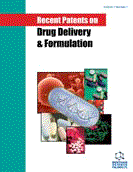Abstract
Aims and Background: The number of pathogenic microorganisms has been increasing over the years, and so as resistance of these microorganisms are developing against various antibiotics. Antimicrobial photodynamic therapy (aPDT), also called photodynamic inactivation, is emerging as a promising alternative to treatments based on conventional antibiotics. Recent patents on structured silver mesoporous silica nanoparticles having antimicrobial activity (WO2010/071831 A2), photosensitiser modified core-shell structure nanocomposites (CN 103536935(A)), and Chitosan-coated magnetic mesoporous silica nanoparticles (MSN) (CN 104785214(A)) helped in selecting method of synthesis of MSN and photosensitizers.
Materials and Methods: MSN were synthesised by Sol-Gel method and amino functionalised (APTES). Methylene blue (MB) and ortho-toluidine blue (O-TB) were used as photosensitisers. Different batches were synthesised. The final product was characterised by using FTIR, BET, SEM, time resolved fluorescence. The photosensitiser loaded MSN were illuminated by LED based lamp emitting red light at 620± 20nm for different time lengths viz 15 min and 30 mins. Fluorescence studies and antimicrobial assays were carried out as per 72 well plate method I.P, 2014 using, gram negative E. coli (ATCC no. 8739), S. aureus (ATCC no. 7447) and gram positive P. aeruginosa (ATCC no. 9027) pathogenic microorganisms.
Results: MB and O-TB were successfully adsorbed on APTES functionalised MSN. Different exposure time length of the photosensitisers to red light showed different zone of inhibition. MB and O-TB loaded MSN showed significant increase in zone of inhibition after irradiation as compared to MB and O-TB loaded on MSN without exposure to light.
Conclusion: MB and O-TB adsorbed on APTES functionalized mesoporous silica nanoparticles were capable of efficiently inactivating E. coli, P. aeruginosa, S. aureus bacteria upon exposure to red light (620± 20nm wavelength) at a much lower concentration. Mesoporous silica nanoparticles played an important role in aPDT due to their high surface area and porous structure. Also, APTES functionalization resulted in the pore expansion of MSN, thereby increasing the loading capacity of the photosensitizer on MSN. From the results obtained it can be concluded that O-TB loaded MSN showed higher activity against gram negative and positive microorganisms microorganism as compared to that of MB.
Keywords: Mesoporous silica nanoparticles, methylene blue, ortho-toluidine blue, antimicrobial photodynamic therapy, gram negative microorganisms, antimicrobial photodynamic therapy.
Graphical Abstract
 29
29 3
3














